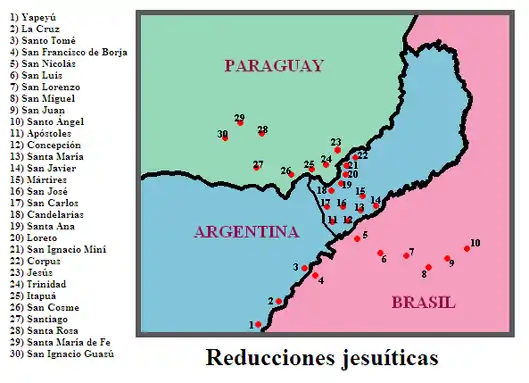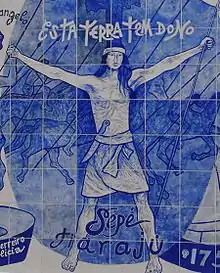Guaraní War
The Guarani War (Spanish: Guerra Guaranítica, Portuguese: Guerra Guaranítica) of 1756, also called the War of the Seven Reductions, took place between the Guaraní tribes of seven Jesuit Reductions and joint Spanish-Portuguese forces. It was a result of the 1750 Treaty of Madrid, which set a line of demarcation between Spanish and Portuguese colonial territory in South America.
| Guaraní War | |||||||
|---|---|---|---|---|---|---|---|
 Location of the most important reductions, with present political divisions | |||||||
| |||||||
| Belligerents | |||||||
|
| Guaraní tribes | ||||||
| Commanders and leaders | |||||||
|
|
Sepé Tiaraju † Nicolás Ñeengirú | ||||||
| Strength | |||||||
| 3,000 men | Unknown | ||||||
| Casualties and losses | |||||||
| 4 dead | 1,511 dead | ||||||
The boundary drawn up between the two nations was the Uruguay River, with Portugal possessing the land east of the river. The seven Jesuit missions east of the Uruguay River, known as the Misiones Orientales, were to be dismantled and relocated on the Spanish western side of the river. The seven missions were called San Miguel, Santo Ángel, San Lorenzo Martir, San Nicolás, San Juan Bautista, San Luis Gonzaga, and San Francisco de Borja. These missions were some of the most populous in South America with 26,362 inhabitants, according to a Jesuit census, and many more in the surrounding areas.[1]
In 1754 the Jesuits surrendered control of the missions, but the Guaraní led by Sepé Tiaraju, refused to comply with the order to relocate. Efforts by the Spanish army in 1754 to forcefully remove the Guarani from the missions failed. On February 10, 1756, a combined force of 3,000 Spanish and Portuguese soldiers fought the Guaraní at the battle of Caiboaté.[2] It resulted in the death of 1,511 Guaraní, while the Europeans suffered only 4 deaths. In the aftermath of the battle, the joint Spanish-Portuguese army occupied the seven missions.
Eventually Spain and Portugal annulled the 1750 treaty in the Treaty of El Pardo (1761), with Spain regaining control over the seven missions and its surrounding territory.
Background
The Jesuit missions were established in the early 17th century by Spanish Jesuit missionaries. For most of the history of the missions the Guaraní fought with Portuguese-Brazilian slavers who sought to capture the Guaraní to sell them in Brazil.[3] The Guaraní were levied to fight for Spain in several colonial conflicts with the Portuguese.[4] The Treaty of Madrid was signed in 1750 to end an ongoing colonial border conflict between Spain and Portugal.[5] The treaty ceded the outpost of Colonia del Sacramento to Spain and set the border between the two colonial empires as the Uruguay River. This new border ceded significant land to Portugal, including seven Jesuit Reductions. The Guaraní living in the seven mission settlements refused to move out of the lands that were ceded to Portugal, or to accept the rule of the Portuguese.[3]
Conflict

The Guaraní refused to accept Portuguese rule and refused to leave the mission settlements. In 1754 Spanish and Portuguese military forces were dispatched to force the Guaraní to leave the area.[6] There was inconclusive fighting throughout 1754 between Guaraní rebels under Sepé Tiaraju and the combined Portuguese and Spanish forces commanded by Freire de Andrade. By the end of 1754 an armistice was signed between the Guaraní and the Spanish and Portuguese forces.[7]
Hostilities resumed in 1756 when an army of 3,000 Spanish, Portuguese, and native auxiliary soldiers under José de Andonaegui and Freire de Andrade was sent to subdue the Guaraní rebels.[8] On February 7, 1756 the leader of the Guaraní rebels, Sepé Tiaraju, was killed in a skirmish with Spanish and Portuguese troops. Three days later the Guaraní were defeated at the battle of Caiboaté. 1,511 Guaraní were killed and 152 taken prisoner, while 4 Spanish and Portuguese were killed and about 30 were wounded.[9] Following the defeat of the Guaraní the Jesuit reductions were occupied by Spanish and Portuguese forces.
Aftermath
After the defeat of the Guaraní rebels, the Spanish and Portuguese forced the Guaraní to abandon the seven reductions that had been ceded to Portugal in the Treaty of Madrid and to move to Spanish controlled lands.[10] According to a census conducted in 1756 the population of the Guarani from the seven missions was 14,284, which was about 15,000 less than the population in 1750.[11] The former Jesuit missions were occupied by the Portuguese-Brazilians until 1759 when Spain unilaterally ended the Treaty of Madrid and reclaimed the lands of the seven missions. The border of the La Plata colonial region was finalized by the Treaty of San Ildefonso in 1777.[12]
In culture
The 1986 film The Mission is loosely based on these events.
References
- Ganson, Barbara Anne (2003). The Guarani Under Spanish Rule in the Rio de la Plata. Stanford, California: Stanford University Press. p. 91. ISBN 0-8047-5495-0.
- Jeffrey D. Burson; Jonathan Wright (29 October 2015). The Jesuit Suppression in Global Context: Causes, Events, and Consequences. Cambridge University Press. p. 84. ISBN 978-1-107-03058-9.
- Owens, David James (1993). "Spanish—Portuguese Territorial Rivalry in Colonial Río de la Plata". Yearbook (Conference of Latin Americanist Geographers). 19: 22. JSTOR 25765781.
- Jackson, Robert H. (Winter 2008). "The Population and Vital Rates of the Jesuit Missions of Paraguay, 1700-1767". The Journal of Interdisciplinary History. 38 (3): 401–431. doi:10.1162/jinh.2008.38.3.401. JSTOR 20143650.
- Reiter, Frederick J. (1995). They Built Utopia: The Jesuit Missions in Paraguay, 1610-1768. Potomac, Maryland: Scripta Humanistica. pp. 116–117. ISBN 1882528115.
- J., Reiter, Frederick (1995). They built Utopia : the Jesuit missions in Paraguay, 1610-1768. Potomac, Md.: Scripta Humanistica. p. 171. ISBN 1882528115. OCLC 32427398.
- J., Reiter, Frederick (1995). They built Utopia : the Jesuit missions in Paraguay, 1610-1768. Potomac, Md.: Scripta Humanistica. pp. 172–173. ISBN 1882528115. OCLC 32427398.
- J., Reiter, Frederick (1995). They built Utopia : the Jesuit missions in Paraguay, 1610-1768. Potomac, Md.: Scripta Humanistica. pp. 191–192. ISBN 1882528115. OCLC 32427398.
- J., Reiter, Frederick (1995). They built Utopia : the Jesuit missions in Paraguay, 1610-1768. Potomac, Md.: Scripta Humanistica. p. 194. ISBN 1882528115. OCLC 32427398.
- Owens, David James (1993). "Spanish—Portuguese Territorial Rivalry in Colonial Río de la Plata". Yearbook. Conference of Latin Americanist Geographers. 19: 15–24. JSTOR 25765781.
- Jackson, Robert H. (2008). "The Population and Vital Rates of the Jesuit Missions of Paraguay, 1700-1767". The Journal of Interdisciplinary History. 38 (3): 401–431. doi:10.1162/jinh.2008.38.3.401. JSTOR 20143650.
- Jackson, Robert H. (2008). "The Population and Vital Rates of the Jesuit Missions of Paraguay, 1700-1767". The Journal of Interdisciplinary History. 38 (3): 401–431. doi:10.1162/jinh.2008.38.3.401. JSTOR 20143650.
External links
- History of the Guarani
- The Madrid Treaty – 1750
- James Schofield Saeger The Guarani under Spanish Rule in the Rio de la Plata - review of the book by Barbara Anne Ganson
- Jesuit Missions
- Harvard Review article on the Guarani and the Jesuits
Further reading
- Barbara Anne Ganson From Resistance to Rebellion - from The Guaraní Under Spanish Rule in the Río de la Plata.